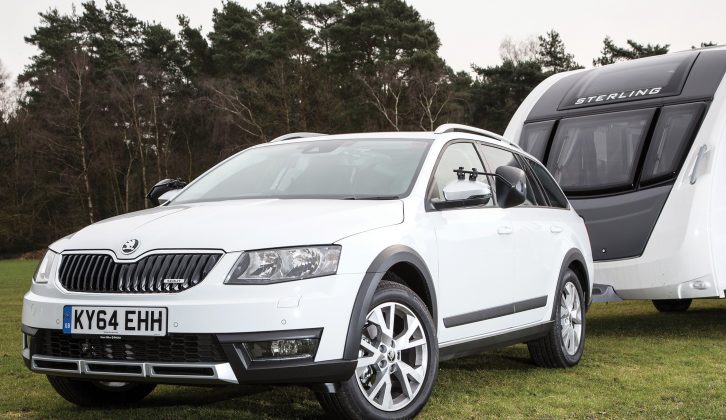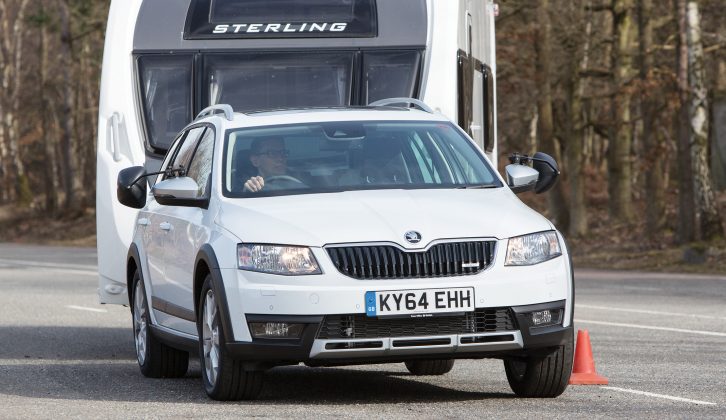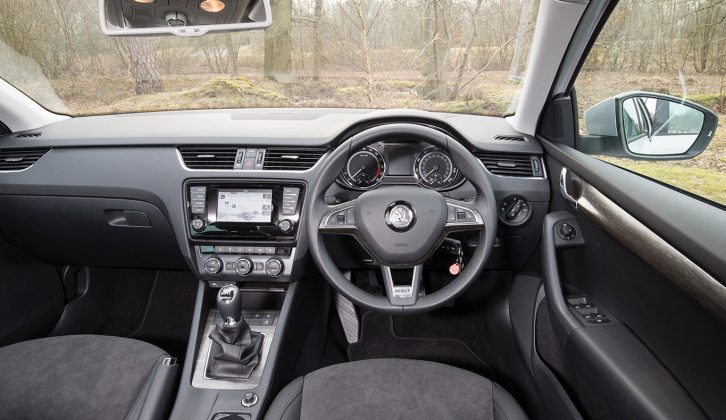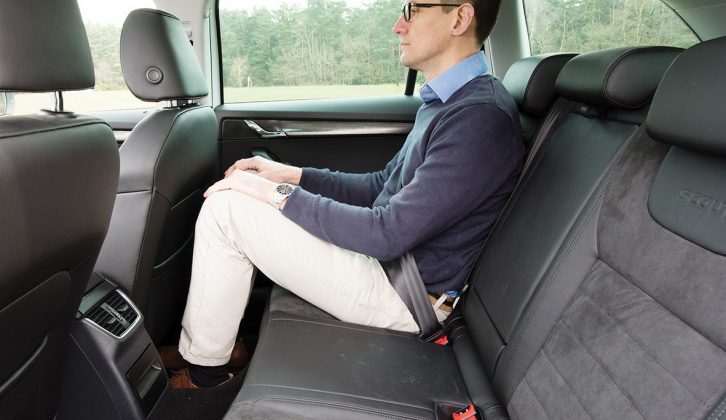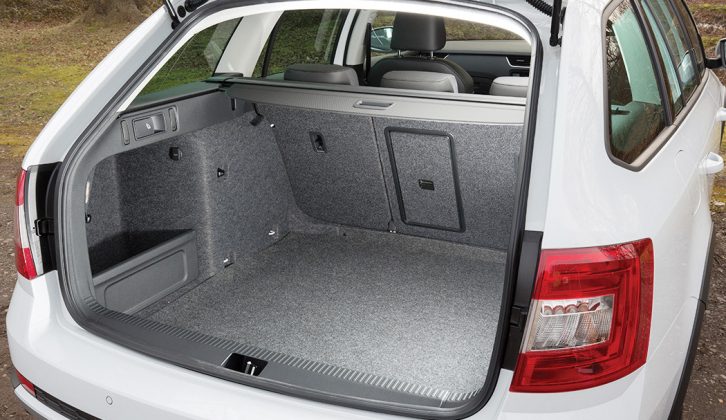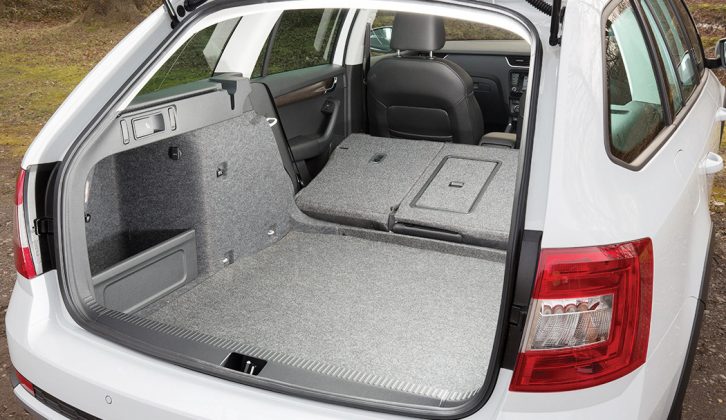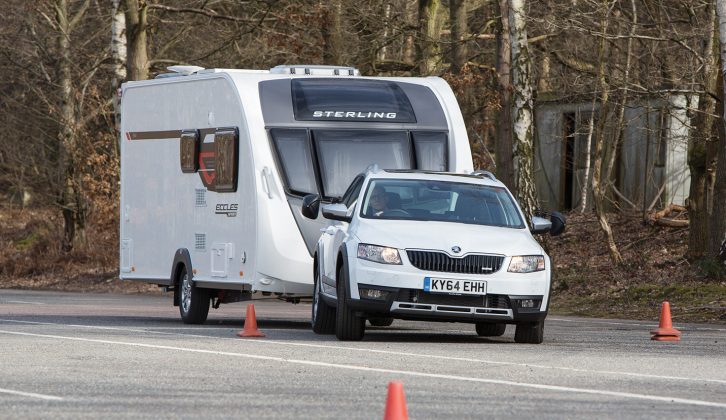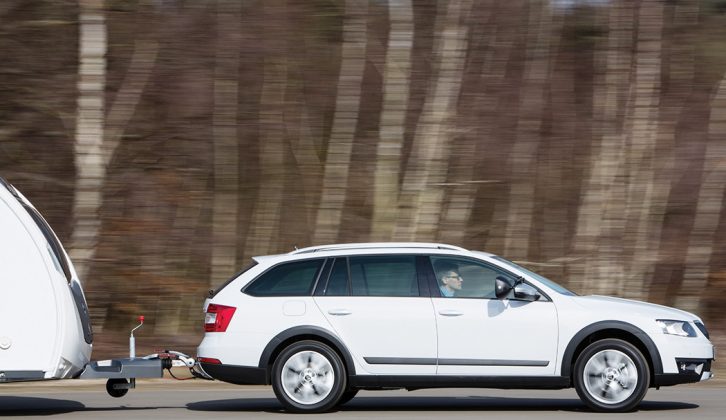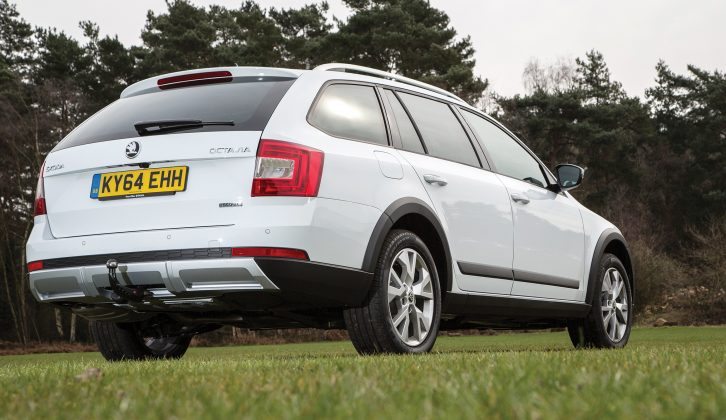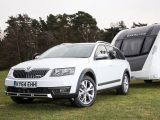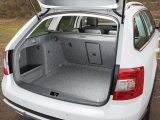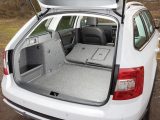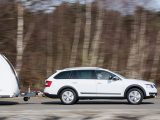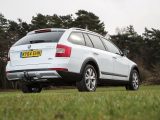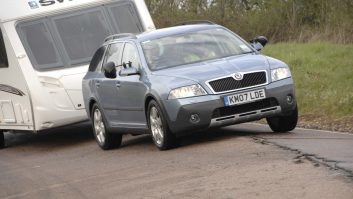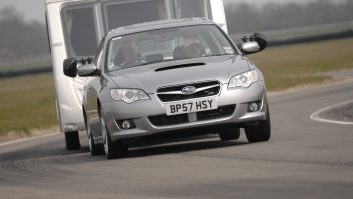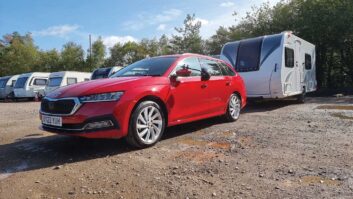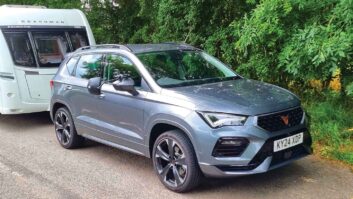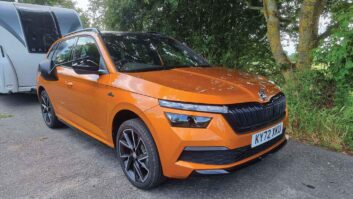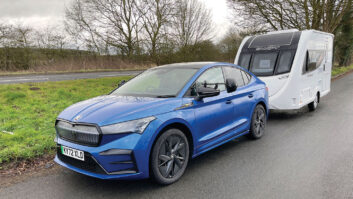Verdict
We’ve yet to drive a Škoda Octavia that doesn’t tow well, and the Scout doesn’t let the side down. Its decent kerbweight, four-wheel drive and the extra torque of its Euro 6-compliant engine make it a very capable tow car.
The Scout is good to drive solo, too. It handles neatly and the ride is on the comfortable side of firm.
The raised ride height makes it easier to travel over bumpy ground, without spoiling the way the car drives on Tarmac. In fact, aside from a little more roll in corners, the Scout is much the same as the standard Octavia Estate from behind the wheel.
Apart from the Alcantara and leather upholstery, it’s much the same in the cabin, too. That’s no bad thing, because the Octavia has always been a very roomy car. Rear-seat space is excellent, and a 610-litre boot gives a larger capacity than you’d find in many cars from the class above.
With a price-tag exceeding £25,000, the Scout is no bargain. However, considering all the features packed into it, the cost isn’t unreasonable. In its favour, you’ll save some money on running costs and insurance.
The only trouble is, if you’re happy enough with the looks of the regular estate and aren’t particularly fussed about having every last gadget, you can have a four-wheel drive version of the Octavia Estate for £2450 less than this latest version.
For many buyers, though, the Scout’s rugged looks and long list of standard kit will be worth paying for.
Pros
A great tow car with strength, speed and stability
Cabin space is good, front and rear
It’s well specced
Boot space is impressive
It has four-wheel drive
Cons
It’s not cheap
It’s more expensive than the four-wheel-drive Octavia Estate
The sat-nav screen is small and set quite low
The Škoda Octavia is one of our favourite small tow cars, and now we’re testing the new Octavia Scout. It’s based on the Octavia Estate but with a raised ride height and four-wheel drive.
It’s heavier than the standard version, which makes it a suitable match for a wider range of tourers, and its ability to send power to all four wheels should make for stable towing in slippery conditions. We’re testing the 150PS (148bhp) model, priced at £25,530.
We’re keen to find out what tow car ability the Škoda Octavia Scout has. Can it justify its price premium over the standard estate, especially because this can be ordered with four-wheel drive? During our test we’ll also scrutinise its credentials as a practical family car.
Not only is this engine greener than the 2.0-litre in the standard Octavia, but it also has more pulling power
Towing
We’re big fans of the regular Škoda Octavia as a tow car, provided you tow a caravan light enough to make a suitable match. The Scout isn’t exactly a heavyweight, but the four-wheel transmission adds heft. Our 148bhp test car weighs in at 1526kg, giving an 85% match figure of 1297kg. The legal towing limit is 2000kg, and the towball limit is 80kg.
The 2.0-litre engine is familiar from Octavias we’ve driven in the past, but the Scout gets the latest version which meets the Euro 6 emissions standard. Not only is this engine greener than the 2.0-litre in the standard Octavia, but it also has more pulling power. With 251lb ft to call upon from as little as 1750rpm, the Scout has a beefy enough mid-range to handle any medium-sized tourer.
We matched the Škoda to a 2015 Sterling Eccles Sport 514 with a Mass in Running Order (MiRO) of 1236kg. The Scout felt at home towing straight away, easily pulling the Sterling up to speed. We attached our timing gear at the test track and found that the Scout needed just 12.2 seconds to go from 30-60mph.
Its in-gear acceleration is also telling. Pulling from 50-60mph in fifth, as you might after being caught behind slower traffic, took just 12.8 seconds.
We’d be quite happy to live with that performance but, for anyone with a heavy right foot or a heavier tourer, there’s a 184PS (181bhp), Direct Shift Gearbox version with 29lb ft more torque.
Once the engine has pulled car and caravan up to 60mph, the Scout is happy to stay there all day. In still air, stability was excellent. Only when the wind picked up and we drove in strong crosswinds did we need to make any steering corrections.
In the lane-change test, the Scout continued to perform well. At moderate speeds, the car kept the caravan firmly in check, while its direct steering and good grip at the front encouraged the driver to push that bit harder. At higher speeds, body roll became more pronounced and we could feel the van starting to push the car, but the Škoda always pulled the tourer straight again.
The Scout’s handbrake held the outfit still on a 1-in-10 slope, and there was no need to pull it on with great force. A little clutch slip was required to tow to the top of the hill, but no more than you’d expect. There was no hot smell from the clutch afterwards to suggest that the car had strained in the hill start.
Our hill-start test took place in dry conditions. You can bet that the car’s four-wheel drive system would have been a benefit if the test had taken place in the rain.
All told, the Škoda Octavia Scout makes a thoroughly impressive tow car. There’s a little more roll if you need to swerve than when towing with the standard Octavia, but the extra kerbweight and four-wheel drive traction compensate. We’d be happy to tow any small to mid-sized tourer with the Scout.
Everyday Driving
So we know what tow car ability this car has and it’s good to know the Scout makes a pleasant car to drive solo, too. It’s a very competent all-rounder.
You really appreciate the engine’s strength when it isn’t hauling the additional weight of a caravan. Even at motorway speeds there’s a determined response to the throttle.
There’s little noise from the engine at the legal limit on the motorway. Wind and road noise are also kept to acceptable levels, which makes the Scout a fine long-distance machine.
On twisty roads there’s slightly more lean in corners than when driving the standard estate but, even so, the Scout drives well. The Driving Mode Selection allows you to alter the throttle, steering and cruise-control settings with a choice of Normal, Eco, Sport and Individual modes. Sport adds a little more heft to the steering but the Normal setting feels about right most of the time.
The suspension is well-judged so, although the ride can be a little firm at low speeds, it’s never harsh. On B-roads and A-roads, it strikes a good balance between comfort and control.
It all goes to make the Scout a very easy car to live with in day-to-day driving.
Space
It’s hard to find any major fault with the Octavia Scout on this score. Whether you need space for passengers or luggage, the Škoda obliges.
Up front, the dashboard design may be rather bland, but the controls are sensibly placed and everything is easy to use. Build quality is good, too, and the wiper and indicator stalks move with smooth precision rather than a sudden click. The seat and wheel have a wide range of adjustment to help drivers of all shapes and sizes settle in comfortably.
At the back, there’s enough space for adults who are more than 6ft tall to relax, even when those in the front are just as tall. There’s noticeably more legroom in the Scout than in the Seat Leon X-Perience, for example. In fact, rear-seat space is on a par with many larger and more expensive estate cars, while air vents between the front seats keep those in the back supplied with chilled air.
The Scout is ideal for families who don’t know the meaning of ‘travelling light’. Even with the seats upright, the boot offers 610 litres of space. It’s a good shape, too: tall and broad, as well as deep. If you prefer a space-saver spare wheel to the standard repair kit, the boot loses 20 litres of capacity, but it’s still very large. Škoda tells us that either puncture repair provision may be used when towing if needed. Levers on either side of the tailgate fold the rear seats, which increases the load area to a massive 1740 litres.
The Scout is very practical. With lots of space for passengers and a boot you could get lost in, it has little to criticise.
Running Costs
The 148bhp Scout costs £25,530. That compares well with the Subaru Outback (from £27,995) and 4×4 versions of the Vauxhall Insignia Country Tourer (from £27,154); Seat’s Leon X-Perience (from £24,385) costs less, though.
Your money buys a long list of standard kit. The Scout is based on the Octavia SE, which has dual-zone climate control, all-round electric windows, rear parking sensors, a DAB radio and more.
The Scout’s improved specification includes larger alloy wheels (17in rather than 16in), underbody protection, a three-spoke multifunction steering wheel, floor mats, Alcantara and leather upholstery, sat-nav, cruise control, an auto-dimming rear mirror and rain-sensing wipers. For some, the most important change will be the styling, which gives the car a much tougher, chunkier look than the standard Octavia SE.
The trouble is, you can buy the regular Octavia Estate with the same four-wheel drive transmission used in the Scout. So if you can live without the extra kit and more imposing looks, you’ll be £2450 better off.
Either way, you can expect running costs to be low. The official combined figure is 55.4mpg, and we achieved 28.3mpg towing on a mixture of A-roads and motorways. The car sits in insurance group 19, so premiums should be affordable.
The Škoda holds its value reasonably well. Our colleagues on What Car? predict that the Scout will be worth 40% of the original price after three years and 36,000 miles.
So, the Scout is a sound buy. However, if we were spending our own cash, we would be tempted to stick with the SE 4×4 and pocket the change.
